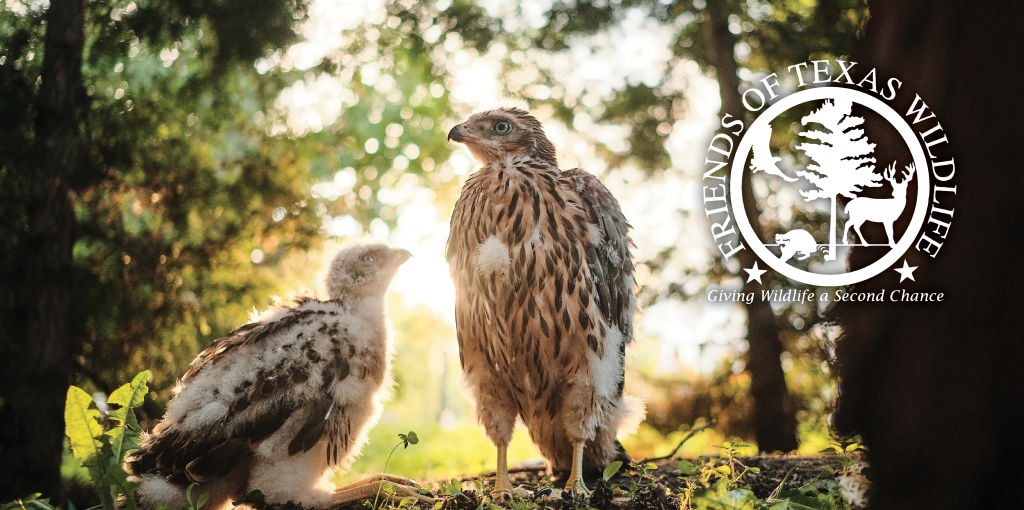Great Horned Owls
Around Southeast Texas, we have four owls that are commonly found. Listing from smallest to largest, we have the Eastern Screech Owl; the Barn Owl; the Barred Owl; and the Great Horned Owl. This month’s article will focus on the largest, the Great Horned Owl.
Great Horned Owls are very adaptable and can be found in urban and suburban areas, as well as rural woods and farmlands. They are the only owl in our area which truly “hoots”, with the male having a much deeper tone to his call than the female. Mated pairs can often be heard calling back and forth to each other late at night as they hunt. The Great Horned Owl can range in size from 18 to 25 inches in height and from 2 to 5½ pounds in weight, with the females being larger than males (as is also true for most species of owls). The “horns” on their heads are neither actual horns nor ears; they are simply tufts of feathers. Their large eyes are bright yellow.
Courtship time generally runs from October through December in our area. Mated pairs are monogamous and will remain together throughout their lives. As with most owls, great horned owls do not build a nest; they will readily use a nest which has been abandoned by hawks, crows, or squirrels, or they will nest in tree cavities, small caves, barns or other outbuildings, window boxes, nest boxes provided by humans, or even very occasionally on the ground. Nesting generally occurs in December/January. The average clutch is 2-4 eggs, which are laid days apart. Incubation usually starts when the first egg is laid. The female develops a brood (bare) patch on her abdomen to help keep the eggs warm, and the average incubation time is 32-24 days. While the female is brooding, the male hunts and provides her with food; once the owlets hatch, both parents will hunt to keep the hungry owlets fed. They are fiercely protective parents and have even been known to attack humans who wander too close to their nesting site. Since the eggs are laid days apart, and they hatch in the same order, the clutch often consists of owlets varying in size; during times when prey is scarce, the youngest and smallest may not survive. The young owlets leave the nest at about six to eight weeks of age, although they cannot yet fly. At this point, they are referred to as “branchers”, and they are very vulnerable, sometimes even winding up on the ground. These fledgling owlets may appear to have fallen from their nest if they wind up on the ground, but in a natural wooded area bushes and smaller trees provide a ladder of sorts and allow the owlets to climb to a higher perch until they can fly. By ten to twelve weeks of age, the owlets will have learned to fly. The parents continue to feed and care for their offspring for several months, often until as late in the year as October.
Great Horned Owls eat a quite varied diet. They are carnivores, and common prey consists of rodents, waterfowl, bats, songbirds, reptiles, amphibians, invertebrates, fish, and small mammals, including skunks. They are one of the very few animals that will routinely predate on skunks as they don’t have a very keen sense of smell. They will also eat carrion. Great Horned Owls will basically eat whatever is available, and they have one of the most diverse diets of all North American owls. Hence, they can adapt to living in a wide variety of habitats, including even urban areas. Smaller prey is swallowed whole, and larger prey is held in the talons while pieces are torn off. As with other birds of prey, Great Horned Owls eat the fur, feathers, and bones along with the meat and organs of their prey. Their stomach acid cannot digest the bones, fur, or feathers; these indigestible items are regurgitated in the form of a pellet, generally once a day. Great Horned Owls will generally hunt at night, but when they have young to feed, they may also be observed hunting during daylight hours.
Great Horned Owls usually have quite a long lifespan. The first year of life is the most challenging, with survival rates dependent on the availability of prey. Once they reach adulthood, survival rates are quite high as they have no natural predators. Natural causes of death would include starvation and hunting injuries, but mortality can also be affected by human impacts. Common reasons Great Horned Owls are injured or killed are being hit by a vehicle; being shot; electrocution; being caught in barbed wire; caught in leg-hold traps; or poisoning due to lead or rodenticides. In the wild, Great Horned Owls can live more than 25 years, and in captivity they can live even longer.
To learn more about what we do and view pictures of many of the animals we assist, please visit our Facebook page at www.facebook.com/SavingTexasWildlife. Details and more specifies-specific flowcharts regarding how to help found animals can be viewed on our website at www.ftwl.org (click on “Help and Advice”). These charts are extremely helpful to determine if an animal truly needs rescuing or not. If you need assistance with a wildlife animal you have found, please call us at 281-259-0039 or email us at ftwl.help@gmail.com. We offer many educational programs (including camps, birthday parties, educational presentations, and Second Saturdays). In 2023, we will be offering day camps during Spring Break as well as several sessions of summer camp. Additionally, our educational visitor’s center is open the second Saturday of each month from 10 a.m. to 2 p.m., located at 29816 Dobbin Hufsmith Road, Magnolia, Texas. Our next Second Saturday will be on February 11 ($5 per person, kids three and under are free).
